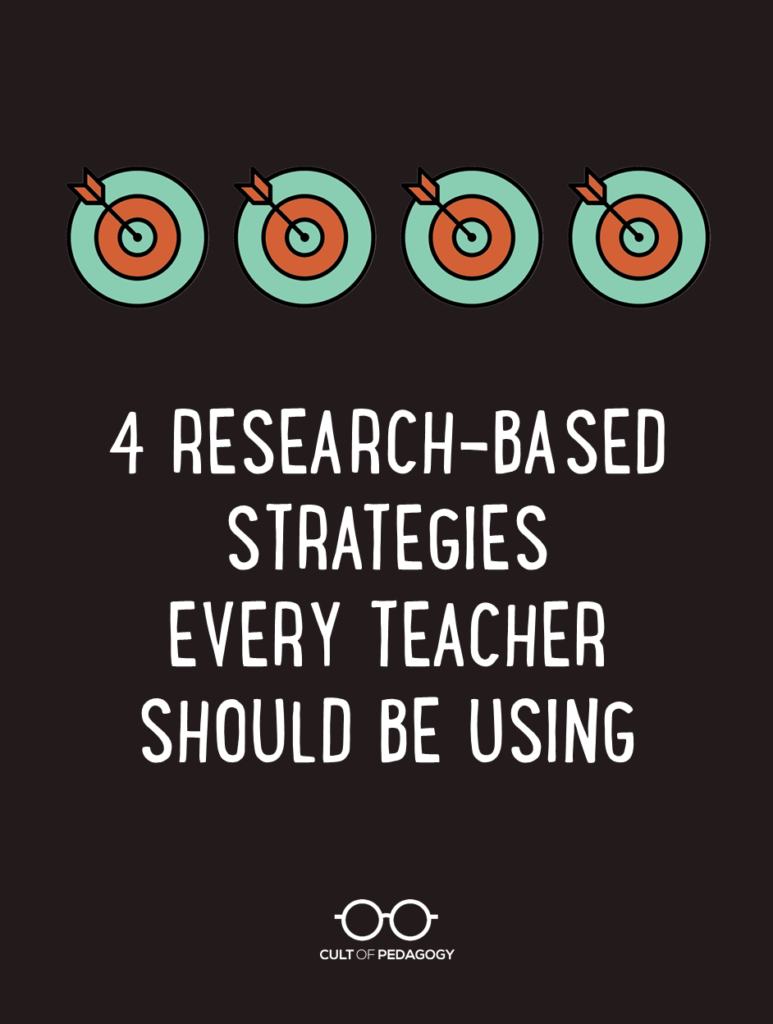
Listen to my interview with Pooja Agarwal and Patrice Bain (transcript):
Sponsored by Pear Deck and Kiddom
This post contains Amazon Affiliate links. When you make a purchase through these links, Cult of Pedagogy gets a small percentage of the sale at no extra cost to you.
If you’ve opened this post hoping to read something brand-new, you might be disappointed. There will be no fancy bells or whistles here.
That’s because a lot of the strategies we’re going to talk about are things you’ve already done; some teachers have probably been doing them for decades. You just might not have known exactly why they worked or how to harness them in the most optimal way.
That’s what cognitive scientists have been doing, trying to pinpoint exactly which activities work best for storing concepts in long-term memory. Over the past few years, we’ve been following their progress: In our 2015 study of the book Make it Stick, we first talked about the concepts of retrieval practice, spaced practice, and interleaving. These concepts were also addressed in the 2016 post Six Powerful Learning Strategies You Must Share with Students, and in 2017, where I made a strong push again for using more retrieval practice in our teaching.
So what’s different this time? Well, until now we haven’t gone very deep into what these strategies look like in the classroom. How exactly should teachers work strategies like retrieval practice into their teaching? Do these strategies replace the ones you’re already using, or do they work alongside them? Will it require extra planning and time to add them in? Where do grading and paperwork come in, if at all?
Now we’re getting specific answers to those questions. Cognitive scientist Pooja Agarwal and K-12 teacher Patrice Bain have collaborated on a new book, Powerful Teaching: Unleash the Science of Learning. In the book, they go into detail about what it looks like when we actually apply four research-based “Power Tools” in the classroom: retrieval practice, spaced practice, interleaving, and feedback-driven metacognition—which is one we haven’t covered at all yet. On the podcast, Agarwal and Bain talked with me about these strategies, the research behind why they work, and some ways you can start using them right away in your instruction.
Why This Book?
Agarwal and Bain have worked together for about 15 years doing research on how children learn. Bain’s sixth-grade classroom was where Agarwal and her colleagues—”Roddy” Roediger, Mark McDaniel, and Kathleen McDermott—did much of the research that found its way into Make it Stick.
Since then, Agarwal says, “We expanded that through (Bain’s) whole school district, and we’ve been working with teachers to really translate this research and make it actionable in the classroom.”
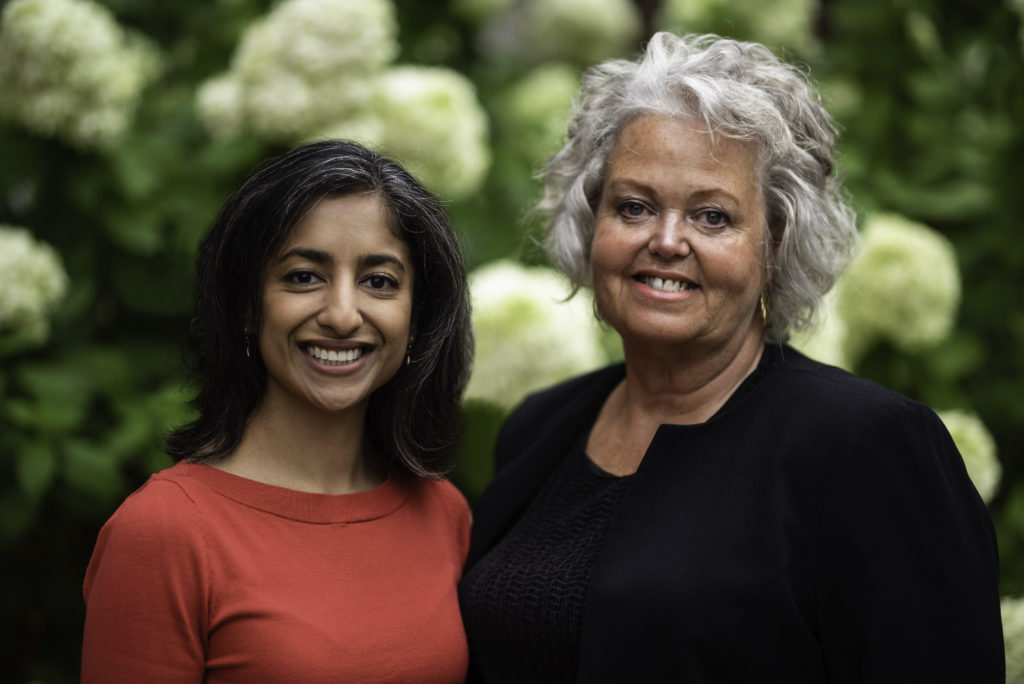
It’s that connection between research and actual classroom practice that motivated Bain and Agarwal to write the book.
“As we were conducting this research,” Bain says, “we were finding what really works in authentic classrooms. And we were taking this research and the principles, and I was able to develop strategies that aligned to this research. And I continued to use these over the years, and it works. The science works. The stress decreases. The students retain knowledge, and it was just so exciting that Pooja and I wanted to share this information with other educators, with parents, with teacher prep programs.”
What may come as a surprise is that these strategies are so simple. “It is not your fad of the semester,” Bain says. “It doesn’t cost a fortune. It is simply techniques and strategies that teachers can incorporate in their classrooms the following day, and the payoff is so great.”
The Power Tools
Strategy 1: Retrieval Practice
Retrieval practice is the act of trying to recall knowledge from long-term memory, rather than constantly feeding it into the brain.
“When students pull information out, when they have to think back,” explains Agarwal, “they then are better able to remember that information for the long term than if they just kind of shove it into their heads. In the classroom we’re often re-reading or lecturing and trying to shove things into students’ heads, and retrieval is really about pulling information out.”
Classroom Application: Instead of assigning homework to give students practice with course material, give mini-quizzes at the start of each class that ask 3-5 questions about the prior day’s learning. These should either receive no grades or be given a very low point value, because the goal of these is to reinforce the learning, not measure or grade student work.
In her social studies classroom, Bain used to assign homework most nights, and found that not only was she spending up to two hours a night grading it, it also was doing nothing to help students retain information.
“So many students have absolutely mastered homework,” she says. “They look at a question, they look up the answer, they write it down and repeat. They get good grades, but they can’t retrieve the information; it’s difficult to discuss the next day, a week later. And so I thought, there’s really a disconnect going on here.”
When she replaced homework with mini-quizzes, she got much better results. “The students started to be able to write down this information. They were able to retrieve. And that made all the difference in students being able to retain the information.”
The new approach also saved her hours of time. “Once I quit giving that homework and gave them mini quizzes,” she says “it would take me about a 15-minute analysis after school to see trends in questions students missed. It gave me a handle on how the students were doing. So it just turned into such a win-win situation. I no longer spent all that time at night, the students were retaining information, and I had a way to check for understanding.”
2. Spaced Practice
In addition to doing regular retrieval practice on material that was covered recently, it’s also important to revisit old information, asking students to retrieve information a few days, weeks, or even months after they learned it. Because that information is harder to recall, it actually makes the learning that comes from it that much more durable.
“We’ve talked about ‘desirable difficulties’ being a phrase that we use in the scientific literature,” Agarwal explains. “It’s desirable to help students engage in more difficult retrieval and spacing as opposed to what Patrice was talking about with the homework where students are simply copying down answers.”
Classroom Application: Spacing is something that can easily be added to any retrieval practice by adding a question that asks students to recall something from an earlier time period in your course.
“You could call these throwback Thursdays or throwback Tuesdays,” Agarwal suggests, “or you just simply ask students, hey, what did we do last week?”
When using spacing, Agarwal warns, teachers should be prepared for some discomfort.
“Students are going to forget,” she says. “I asked my college students this past week, hey, it’s Week 12, think back to Week 3 of this semester. What are two things you remember about neuroscience? I just got blank looks from students, which is okay. At first they were uncomfortable, and at first I’m like, Gee, I didn’t teach that very well. But it’s actually a benefit. It’s a bit counterintuitive, but it’s important for students to forget. Because with spacing, they bring it back up, and that then solidifies that learning moving forward.”
3. Interleaving
Rather than asking students to retrieve similar types of information in one continuous session, apply the principle of interleaving, which mixes up content from different areas. “Students retain and learn more information when they mix it up,” Agarwal explains.
Classroom Application: Resist the temptation to let students “get on a roll” with practice or retrieval, mixing up retrieval tasks instead.
To illustrate how this works, Agarwal provides an example from math: “If students know that they’re learning how to multiply fractions and then how to divide fractions, which is always tricky, if they know they’ve got 10 multiplication problems, they can just, what I call ‘plug and chug,’ right? They know, I’m just going to follow the same procedure for these first 10 questions, and then I’m going to use division. But if you mix those up, then students have to choose the strategy.” This prevents students from just repeating the same procedure over and over.
“With interleaving, mixing up very similar things provides that challenge where students have to know the difference, choose a strategy, and that then helps their learning.”
4. Feedback-Driven Metacognition
“When you study, and you don’t do well,” Bain says, “often it is because you were studying what you already knew. It feels better. It’s like, oh, I’ve got this. And not studying what you don’t know. Feedback-driven metacognition is being able to help students learn how to discriminate between what they know and what they don’t.”
Classroom Application: Feedback-driven metacognition can be applied during retrieval practice; Bain does it right after giving her mini-quizzes. “As soon as they were over, I would go over those answers so the students would know right away if they got them correct or not. The following day, after I had done my analysis after school and I handed them back, I would go over the questions again and allow them to retrieve the answers. So they’re not only getting feedback again, but I’m incorporating spacing.”
Just like the other strategies, implementing this takes very little time. “Being able to present the information when I go over the answers, it takes, what, 90 seconds perhaps?” Bain says. “But they have a chance to retrieve and to space. And then when I do a blast from the past—Hey, remember when we did such and such? —again, either they knew it right away or they had a desirable difficultly, but they again were testing their metacognition, and then by having a pair and share, having students discuss, they’ve been able to test their metacognition too.”
What You Do Already, But Better
“Many teachers might be doing some of these things already,” Bain says, but what she and Agarwal hope to accomplish with their book is help teachers get a better understanding of why they work, “to be able to learn about the science behind why they work, and also to take a look at how purposeful you are in using these strategies in your classroom. The beauty of this is to find out why we should be doing them, and how to incorporate the principles so we can do them even better.”
Learn More
To learn more about specific ways to use these tools, grab a copy of the book, Powerful Teaching. Follow Pooja Agarwal on Twitter at @RetrieveLearn, and Patrice Bain at @PatriceBain1.
Join our mailing list and get weekly tips, tools, and inspiration that will make your teaching more effective and fun. You’ll get access to our members-only library of free downloads, including 20 Ways to Cut Your Grading Time in Half, the e-booklet that has helped thousands of teachers save time on grading. Over 50,000 teachers have already joined—come on in.

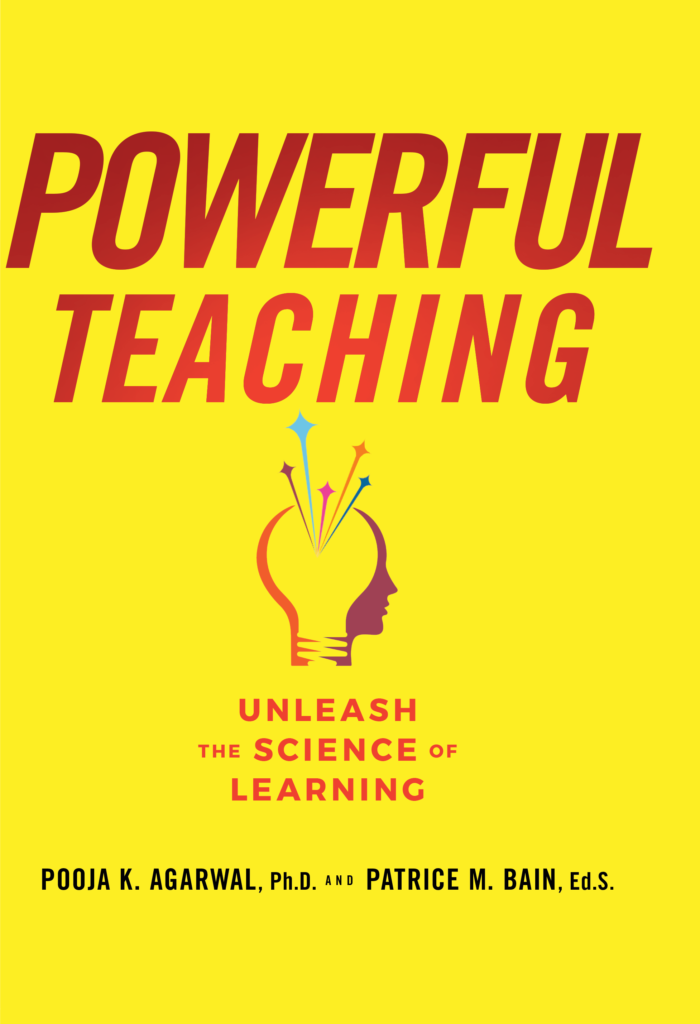
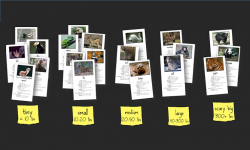

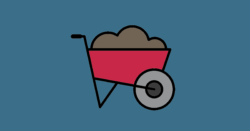

Thanks for the important information! I have a question about spacing. When the students exhibit their blank looks (can’t recall), what are the suggested strategies for getting them on track at that moment?
Thank you!
Hi Julie! First, making errors during retrieval practice is a /good/ thing. We learn a lot from our mistakes! When students can’t recall, that’s an critical opportunity for feedback-driven metacognition. Provide students with a hint and then incorporate spacing by asking them to re-retrieve later that day or a few days later. We have a chapter about spacing in Powerful Teaching, and a free guide at retrievalpractice.org/spacing.
I have been advised by special education teachers to group similar types of questions on assessments. This seems to be at odds with the concept of interweaving. How might teachers implement that strategy without causing problems for students?
You bring up a great point! Earlier this year, when I was reading quite a bit of cognitive science, a thought took root and started to grown. Insights from the science of learning strongly suggests that the more effort we put into retrieving longterm memory, the stickier the learning. Basically, effort is desirable for learning (stated in this podcast episode as a desirable difficulty). That being said, a lot of what I see functioning with IEPs tends to remove the responsibility of effortful retrieval from the student. This leads me to believe that a resource designed to help students may actually be harming their learning?
Don’t get me wrong, I have seen wonderfully designed IEPs that help match the student and the teacher with an accommodation that allows a student to access the learning in an equitable manner to his/her peers, and that keeps the onus of effortful retrieval as the student’s main responsibility. And I have also observed IEPs that appear to enable a capable student to avoid effort.
What I am getting at, I think, is a question: To what extent should the insights of cognitive science be used to inform the development of individualized education plans for our students who need accommodations?
I am an Instructional Coach in the Chicago suburbs, and I think your question relates to the difference between learning (formative assessment, not graded or lightly weighted), and assessment (summative–performance-time). The interview suggests teachers guide students through interleaving with the low-stakes mini-quizzes. I think on a final test, grouping content might be more fair given the limits of multiple-choice testing, particularly for students with IEPs.
Excellent points about cognitive science informing IEPs and special education students, Jeffrey and Scott. As a cognitive scientist, I feel that more research needs to be done on diverse students (ability, backgrounds, and more). I agree with Jeffrey that sometimes we worry about students making mistakes (something we discuss frequently in Powerful Teaching) and that we need to encourage all students to engage in retrieval practice more often, including students in special education programs. Thank you both for sharing your insights.
Hi Craig! Could you share an example about grouping similar types of questions that you have in mind? Here’s an example I hope is helpful: rather than having students complete a block of addition problems, then subtraction, then multiplication, it’s more beneficial for learning to mix up the types of problems. Special education students may need additional scaffolding. Thank you for your question.
I am a special educator. A simple accommodation that can be implemented for any student is simply making a key word in bold or making a math symbol slightly larger to make sure they are noticing the key word or symbol. As with any accommodation, it should be faded with time, if possible.
Great post! These four strategies got me thinking about curricular ideologies and where they would fit under these frameworks. Before taking a course in ‘Integrated Planning, Instruction and Assessment’, I was unaware of the terminology used to describe various curriculum ideologies and frameworks. After reading articles, watching videos, and understanding the different curriculum frameworks, I started to think about where I stood as an educator. When thinking about instruction and assessment within your teaching practice, what type of curricular conceptions do you lean towards?
Here is some information on a few of the ideologies:
Scholar Academic Ideology is like a hierarchy in which you come in as a student and as you learn you go up. Competent teachers teach students and scholars are at the top of this hierarchy. The main purpose of this ideology is for learners to focus on a field that interests them and encourages them to study further.
The Social Efficiency Ideology looks at teaching students the necessary skills required in everyday life to be good citizens in their communities. It puts an emphasis on real-world scenarios and teaching youth effective strategies that will be of use to them in society.
The Social Reconstruction Ideology puts a focus on bettering society and social reform. Students are encouraged to use their skillsets to help solve problems within their communities.
The Learner-Centered ideology, as the title speaks for itself, focuses on the learner and their growth/capabilities. The role of the educator within this type of ideology is to ensure that the environment, instruction and assessment are centered on the learner’s abilities and needs.
After reading a little bit about these ideologies, which curricular conceptions do you resonate with the most and implement in your teaching practice? Could you provide some examples of planning, instruction, and assessment related to these frameworks.
Thank you for sharing this framework, Amy! I wasn’t familiar with it and I’m glad to know more. I feel that the four power tools we discuss in Powerful Teaching apply to all four of the curriculum ideologies you describe. Specifically with the four ideologies you outlined: 1) Scholars should facilitate retrieval practice and feedback for students, 2) when students remember information for the long-term, I feel they can be more effective citizens in society, 3) when learning improves, students can solve problems more flexibly, and 4) students can harness and unleash the power tools independently outside the classroom when provided opportunities and modeling inside the classroom (we discuss this point in particular in an entire chapter of Powerful Teaching). I hope my comment is helpful as you explore curriculum ideologies further.
Thank you for this post connecting research to what it can look like in my classroom! I’m currently working on my teaching certificate and while I love the theoretical background I’m getting in my classes, it’s not always clear how to bridge the gap between theory and practice. I’m excited to look into this book. This post has gotten me thinking about the balance between theoretical and practical teacher training. While I don’t think that theory alone is enough to develop talented educators, I’ve also noticed that sometimes clearer “how-tos” in applying researched methods to classroom teaching can lead to oversimplification of the theory. I’ve seen that sometimes teachers can get into a rut of applying “research-based” methods in ways that follow advice or instruction they’ve gotten in PD or from administrators, but that don’t truly benefit students in the ways in which they are intended to. Do you have any advice for a beginning educator in balancing theoretical vs practical advice from others?
I couldn’t agree more, Emma! When I went through teacher training and got certified in elementary ed, I found the theory and practice to be isolated from each other. The theory didn’t inform practice, and I frequently worried that the practice wasn’t based on research. In Powerful Teaching, we aimed to make sure that both theory/research and practice are intertwined. Regarding PD specifically, we provide two entire chapters to empower schools and teacher prep programs to understand and share the science of learning. We have 100+ discussion questions and a “lesson plan” for PD. We do the work to help beginning educators balance theoretical and practical advice! Thank you for all you do in your classroom!
Agree this podcast’s intro that we “knew already,” but now understanding the research and purpose behind the practice sets it up for deeper teaching enrichment. The Interweaving Strategy echoes what I learned in college named “Across the Curriculum;” highlighting how a particular curriculum’s lesson also touches upon other curriculums (e.g. Music interweaves with Math, History, etc.). Excellent!